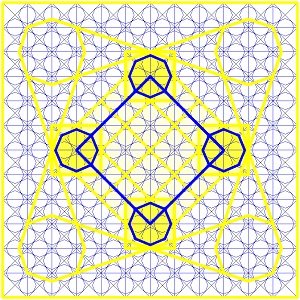Before continuing on with describing the "C" Register I want to show some of the "Components"
to do with the Main "Temporary Library" and "Running Program" Registers.
The 1st "Instruction" to show, is the Instruction, requesting the "Running Program" Register.
If we examine the "+" Instruction it points to 5 "Locations";
a. The Upper Running Program Register.
b. The Lower Running Program Register.
c. The Left hand Register.
d. The Right hand Register.
and
e. The Center.
It is these Outer Registers which produce the Inner "Running Program" Registers.
Pay attention to the Outer Registers in YELLOW and note the Corner Registers
a of a Group of 16 Registers on Edge.
The 4 sub-bits (Look like "V's". 3 of which are Rotations of an Instruction, looking like
a wide "V" (the angel between the 2 bars forming the "V", is 90°.
These form the Register "Mask" or/and "Frame".
The same Scenario produces the Main "Temporary Library" Registers.
Through a "Slide and Rotate" Function,
the "Instruction" is now in the form of a "X".
Which point to these 4 Registers, which produces the Main "Temporary Library" Registers.
Pay attention to the Outer Registers in YELLOW and note the Corner Registers a of
another Group of 16 Register.
The Result.
As a Frame and "Mask".
or just a Frame, without a "Mask".
The "Data" is contained in the "Line Work". (Conceptually)
To access any register involved in this, is through the "Octagonal" Registers behind the Line
in this case the "Square Frame".
Remember these Octagons are "Geometric Instructions".
There are 2 Sets of Primary Octagons under the "Square Frame".
Here is One set of "Octagons" of these 2.
And the 2nd set of "Octagons" of these 2.
It is in this 2nd set of "Octagons", we find the corners of the "Running Program" Registers.
And behind the Frame of the "Running Program" Register, is another 2 sets of "Octagonal" Registers.
And the 2nd set of Octagonal Registers.
This leaves 4 Octagonal Registers placed In between these 2 "Frames".
So now back to the "C" Register.
The Instruction for the "C" Register.
Which enables an "Octagonal Ring" of Octagons.
The "C" Instruction shown in above Drawing, enables an Octagonal Ring of 8 Octagons.
The "C" Instruction can relate to other Octagonal "Rings" of Octagons.
This is dependent on the "Instruction", which is pared with the "C" Instruction.
Which enables the Octagonal "Ring of 12" Octagons.
And this "C" Instruction enables the "Ring of 16" Octagons.
This "Ring" of Octagons is used to Import items from The Main "Libraries" which Contain
a copy of some "Contents" from the Permanent "Libraries".
The Curved "X" instruction shown in the Drawing above Selects the Main "Temporary Libraries".
Note the Intersection of the Line Work, involving the upper of the 4 Octagons in the Center.
Here is a Drawing showing the Smaller "C" Instruction.
And the Rings of Octagons they Enable.
Note how 4 Octagons in each set, align with the Octagons in the "Partition Map".
And if this "C" Instruction is in the Center,
None of the Octagons align with the Octagons in the "Partition Map"
But remember the "Partition Map" is used to know where we are in the "Processing System".
If All the Octagons were shown together, all we would see, is a BLACK "Square",
so this is why only the small Octagons of the "Running Program" Registers are Shown
in the "Partition Map".
This Ring also has 2 Sets of Octagons just as the other "Rings" have too.
This Drawing shows the 2nd set of 8 Octagons.
Notice how these Octagons align with the "Partition Map".
This next drawing shows both Sets of Octagons.
And the "Rings" of Larger Octagons also have 2 Sets of Octagons.
The 1st Set of 8 Octagons.
Here is the 2nd Set.
And both together.
There are 2 Parts to the "C" Instruction.
1. The Ring of Octagons
and
2. The Outer Registers these are "Linked" to.
So let's take a look at the locations and size of the Outer Registers the "Ring of 8" Octagons
shown in the previous three drawings are Linked to. And why a "C" is used to enable
the "Ring" of Octagons in stead of a Circle.
1st the Outer Registers that the Ring of Octagons is "Linked" to Indicated by the Geometry
of the "C".
Note that the Ends of the Semicircle forming the "C" intersect with 2 Octagons Highlighted
in YELLOW.
And again here, showing the "Square" Registers the 2 Ends of the Line Work of the "C"
terminate in.
Note the sub Registers shown here in BLUE.
NOTE;
To gain the full understanding, please Start this "Thesis" from the beginning at 0001
































